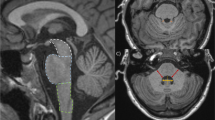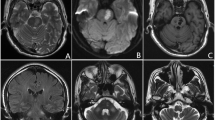Abstract
In comparison with the lateral (Wallenberg), medial (Dejerine) and hemimedullary (Reinhold) medulla oblongata syndromes, the Babinski-Nageotte and Cestan-Chenais syndromes are much less familiar cerebrovascular disorders. While the Babinski-Nageotte syndrome is usually confused with the hemimedullary syndrome, reports of the extremely rare Cestan-Chenais syndrome are missing from the modern neurological literature. The pathological and magnetic resonance imaging (MRI) correlations of the Cestan-Chenais syndrome have not been shown so far. We compared clinical and MRI features of two patients exhibiting classical Babinski-Nageotte and Cestan-Chenais syndromes according to their original descriptions with those of three patients with lateral, medial and hemimedullary syndromes. Our study shows that Babinski-Nageotte syndrome includes all symptoms of the Wallenberg syndrome and additionally contralateral hemiparesis due to a spreading of the “Wallenbergian” lateral lesion to the pyramidal tract. The Cestan-Chenais syndrome includes all symptoms of the Babinski-Nageotte syndrome with the exception of the ipsilateral cerebellary hemiataxia because of sparing of the posterior spinocerebellar tract. The Babinski-Nageotte syndrome is neither clinically nor on MRI identical with hemimedullary syndrome. Hypoglossal palsy, an invariable symptom of hemimedullary lesion is not part of the Babinski-Nageotte syndrome. The contralateral hypesthesia is dissociated in the Babinski-Nageotte syndrome. The Babinski-Nageotte and Cestan-Chenais syndromes are intermediolateral medullary syndromes with all (Babinski-Nageotte) or nearly all (Cestan-Chenais) features of the lateral and some features of the medial medulla oblongata syndromes.





Similar content being viewed by others
References
Babinski J, Nageotte J (1902) Hemiasynergie, lateropulsion et myosis bulbaires avec hemianesthesie et hemiplegie croisees. Rev Neurol (Paris) 10:358–365
Campbell WW (2005) DeJong’s neurologic examination 6th Edn. Philadelphia, Lippincott, Williams & Wilkins, Philadelphia, pp 277–296
Cestan R, Chenais L (1903) Du myosis dans certaines lesions bulbaires en foyer. Gazette des hopitaux 76:1229–1233
Chang YY, Wu HS, Chen WH, Liu JS, Chen SS (1993) Babinski-Nageotte syndrome: a case report. Gaoxiong Yi Xue Ke Xue Za Zhi 9:595–598
de Freitas GR, Moll J, Araujo AQC (2001) The Babinski-Nageotte syndrome. Neurology 55:1604
Dejerine J (1914) Semiologie des affections du systeme nerveux. Masson et Cie, Paris
Giraud G, Oliver G, Simon L, Dauverchain J (1960) Cestan-Chenais syndrome. Developmental and etiological peculiarities apropos of 2 cases. Montp Med 57:499–502
Irie F, Toyoda K, Hagiwara N, Fujimoto S, Okada Y (2002) Babinski-Nageotte syndrome due to vertebral artery dissection. Intern Med 42:871–874
Kameda W, Kawanami T, Kurita K, Daimon M, Kayama T, Hosoya T, Kato T (2004) Lateral and medial medullary infarction: a comparative analysis of 214 patients. Stroke 35:694–699
Krasnianski M, Neudecker S, Schluter A, Zierz S (2003) Babinski-Nageotte’s syndrome and hemimedullary (Reinhold’s) syndrome are clinically and morphologically distinct conditions. J Neurol 250:938–942
Krasnianski M, Neudecker S, Schluter A, Krause U, Winterholler M (2003) Central Tapia’s syndrome (“matador’s disease”) caused by metastatic hemangiosarcoma. Neurology 61:868–869
Kim JS, Lee JH, Suh DC, Lee MC (1994) Spectrum of lateral medullary syndrome. Correlation between clinical findings and magnetic resonance imaging in 33 subjects. Stroke 25:1405–1410
Mossuto-Agatiello L, Kniahynicki C (1990) The hemimedullary syndrome: case report and review of the literature. J Neurol 237:208–212
Nakane H, Okada Y, Sadoshima S, Fujishima M (1991) Babinski-Nageotte syndrome on magnetic resonance imaging. Stroke 22:272–275
Okada M, Kooyama Y, Ueda S, Matsumoto K (1978) A case of Cestan-Chenais syndrome associated with repetitive episodes of the lateropulsion. Rinsho Shinkeigaku 18:44–51
Reinhold H (1894) Beiträge zur Pathologie der acuten Erweichungen des Pons und der Oblongata. Zugleich ein Beitrag zur Lehre von der “bulbären Ataxie”. Dtsch Z Nervenheilkd 5:351–374
Tada M, Tada M, Ishiguro H, Hirota K (2005) Babinski-Nageotte syndrome with ipsilateral hemiparesis. Arch Neurol 62:676
Tatu L, Moulin T, Bogousslavsky J, Duvernoy H (1996) Arterial territories of human brain : brainstem and cerebellum. Neurology 47:1125–1135
Tsukagoshi H, Inoue K (1977) Cestan-Chenais syndrome. Nippon Rinsho 35:480–481
Wallenberg A (1895) Acute Bulbäraffection (Embolie der Art. cerebellar. post. inf. sinistr.?). Arch Psych Nervenheilkd 27:504–540
Author information
Authors and Affiliations
Corresponding author
Additional information
Received in revised form: 15 March 2006
Rights and permissions
About this article
Cite this article
Krasnianski, M., Müller, T., Stock, K. et al. Between Wallenberg syndrome and hemimedullary lesion. J Neurol 253, 1442–1446 (2006). https://doi.org/10.1007/s00415-006-0231-3
Received:
Accepted:
Published:
Issue Date:
DOI: https://doi.org/10.1007/s00415-006-0231-3




